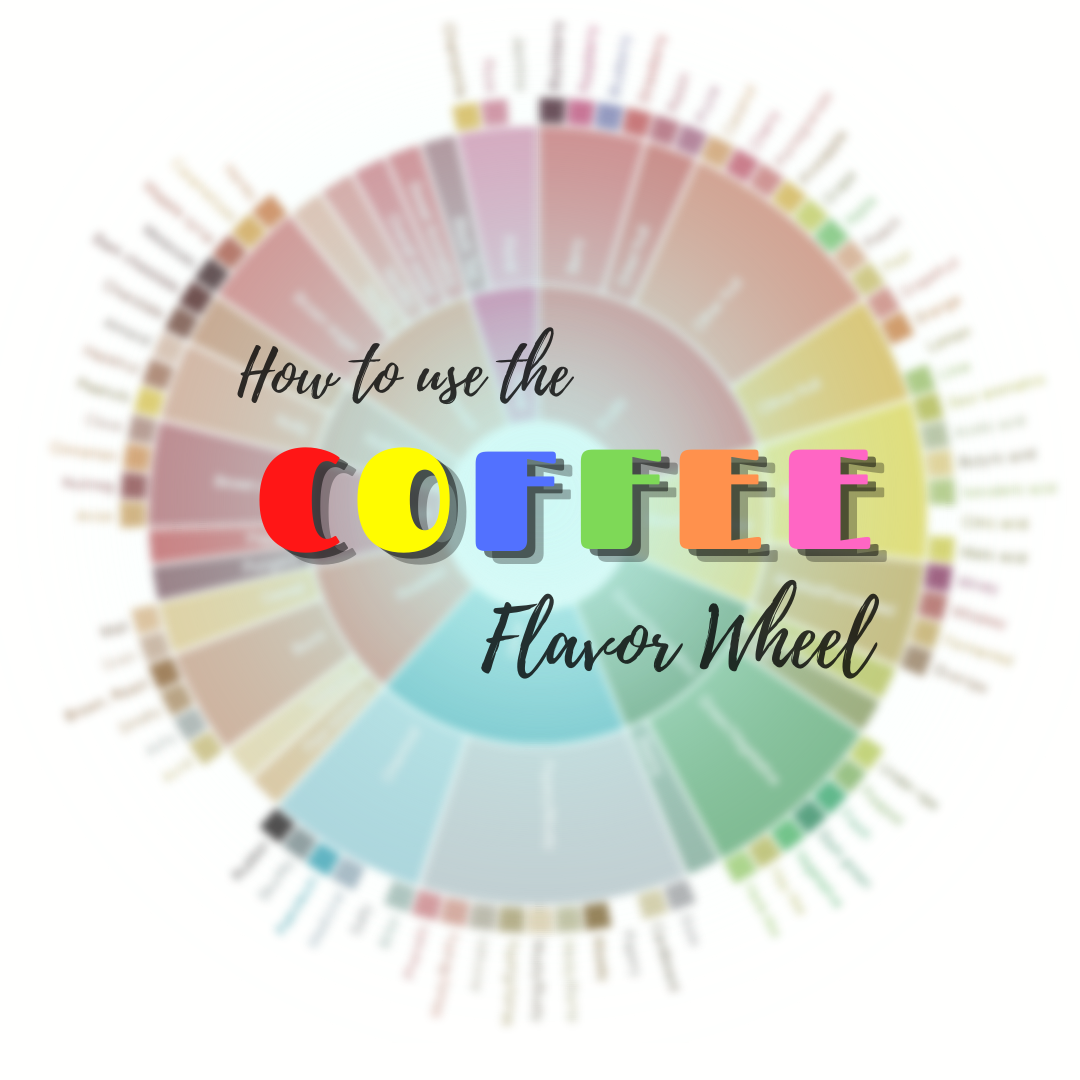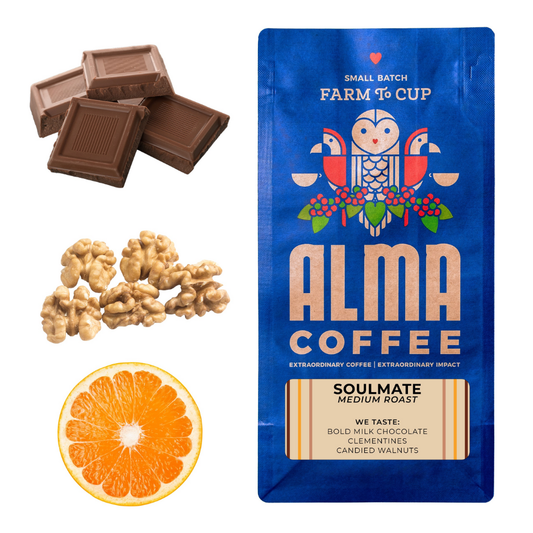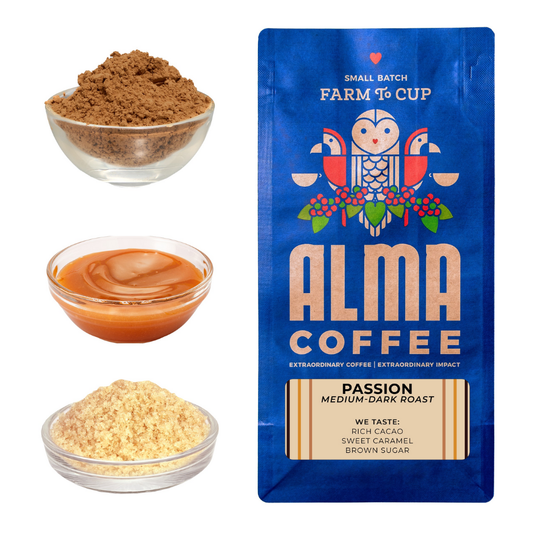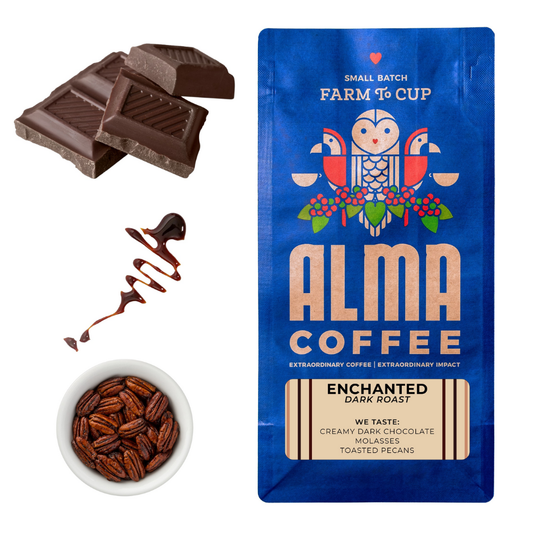
How to Use The Coffee Flavor Wheel
Share
If you’re reading this, it’s safe to assume that you probably enjoy coffee more than your average (cup of) joe. If you’re drinking a fresh cup right now, take a sip of that delicious brew, savor the flavor, and ask yourself a few questions: What are you tasting, what do you like about it, and why?
Coffee, from its natural cherry fruit to final roasted bean state, is a complicated flavor experience that can be intimidating for newcomers and professionals alike; but, everyone experiences their favorite coffee just a bit differently depending on their own tastebud’s preferences, and those preferences vary wildly from person to person. So how do you know what flavors you like in your favorite Alma coffee roasts?
This week’s Alma-nac blog is intended for coffee drinkers of all metaphorical walks of coffee life: we want to introduce you to the iconic Coffee Flavor Wheel, explain a bit about how and why it exists, and then show you how to use this infographic to quickly and easily pinpoint specific flavors you like/dislike in your favorite cup of coffee!
There are Flavors in my Coffee?!
We could spend an entire blog talking up just how complicated the coffee flavor experience can be for even the most seasoned coffee professional (no, seriously, coffee activates more than 2x the amount of flavor bud sensors than wine...!)
However, it’s probably a better idea to clarify right off the bat that flavor and taste are actually two different experiences:
- When we say “taste” in this specific blog post, or really anytime we refer to a coffee’s tasting notes, it’s always in reference to what is exclusively happening on our tongue.
- "Flavor," on the other hand, is always in reference to the convergence of all five senses experienced at once; For coffee specifically, that could mean sight, smell, texture and taste, but it doesn’t always have to be (WineFolly.com).
You might be wondering what that means for you and your cup of coffee you’re sipping on right now, and we don’t blame you: The taste and flavor of a final cup of brewed coffee is dependent upon a wide variety of factors from the farm the coffee was grown on, the wet or dry processing of that coffee cherry, the roasting profile, and sometimes the *literal* addition of post-roast flavorings.
But, regardless of how or why your favorite coffee’s flavor notes hit your tongue, the concept of scientifically pinpointing those flavor notes in a specific and descriptive way is a relatively new addition to the coffee world.
A (brief) History of the Coffee Flavor Wheel
We covered the history of coffee in consumer culture in our Great Coffee Waves blog post, so we’ll save you the lecture on how the 1990s spawned the second wave of popular coffee culture. But, as of the publishing of this blog post, the 1990s really wasn’t even that long ago; it’s a little shocking to know that the first version of the coffee flavor wheel was created sometime in 1995 by the Speciality Coffee Association (SCA).
It was around this time in the mid-90s that specialty coffee started gaining enough momentum in popular culture to warrant more specialty coffee roasters than the world had previously ever seen. So, with so many new coffee roasters popping up at once and an ever-increasing demand on the consumer side, roasters had to find a way to make their coffee “stand out” above the competition.
This is when the iconic Coffee Flavor Wheel infographic first started appearing in roasters and cafés around the world.
Think about it from a marketing standpoint alone: there is so much more to coffee than just “light” vs. “dark” roasts, and the stereotypical adjectival descriptors used to describe coffee before the second wave of the 1990s are still common features of our coffee lexicon despite meaning nothing in a literal sense (ex: this coffee tastes “strong” “bitter” “weak” “smooth” etc.)
Coffee nerds knew there was a better way to translate their roast’s unique flavors to the end consumer, and thus the coffee wheel became a ubiquitous and easy reference tool. Over the course of the last 25 years the SCA has modified and improved the Coffee Flavor Wheel from its first 1995 version in order to make the lexicon and methodology more empirical.
In 2015, for instance, the Sensory Analysis Research Center at Kansas State University modified and identified over 110 specific aromas, flavors, and textures found in the most common strains of coffee and update the entire flavor wheel accordingly. This update to the flavor wheel is often referred to as “the largest collaboration in the history of the coffee industry” (from the SCA).
So, how do I read the coffee flavor wheel?
Finally, the moment you’ve been waiting for—it’s time to learn how to read and use this infographic for yourself!
Like we mentioned at the beginning of this blog, coffee is a really, really complicated flavor experience and also really, really varies from person to person. The cool thing about the Flavor Wheel is that it has been designed and revised with these complications in mind: using this thing can be as simple or as complicated as you want it to be, so keep that in mind!
The “center out” approach
At a quick glance, the coffee flavor wheel is actually more approachable than it seems.
Most coffee nerds agree that the “center out” approach is the best methodology for newcomers to the wheel, but experience coffee connoisseurs likely have their own strategy that develops over time.
Essentially, the 9 flavors you see in the innermost center section of the coffee wheel are the most generalized, macro descriptors for coffee flavors. As you sip your favorite coffee, it’s probably a good idea to start here and then “move out” as you start getting more specific flavor notes.
What do the colors and arrangement represent?
After the SCA updated the wheel in 2015, the wheels’ actual visual design was given a rebranding to also be more accurate and accessible (from Trade.com). More specifically, when looking at the outermost ring of the Flavor Wheel and seeing how tightly the flavor notes are arranged, it’s easy to not think about how different flavors contrast with each other.
On top of trying to match specific colors with specific flavors (for example, lemon = yellow), opposite ends of the flavor wheel are meant to represent contrasting flavors. Let’s take a look at the “Grain” flavor on the wheel: on the opposite side of the infographic “Lime” sits perfectly poised to face “Grain.”
According to the SCA, these two flavors are meant to “cancel each other out” in a raw taste test, so tasting one flavor means its contrasting flavor note on the opposite side of the wheel will not be present. In Dark vs. Light roasts, this specific aspect of the flavor wheel really makes the most sense, although it is important to note that this rule isn’t always 100% accurate.
Now it's your turn!
Although we may have given you the insider knowledge needed to read and use this wheel, a huge component of pinpointing flavor in coffee comes from experience and personal taste. This wheel is intended to be a guide for roasters and coffee connoisseurs to identify reasons why they like or dislike a certain coffee, but these same experts also have trained themselves to target and identify certain flavors when tasting coffee in order to improve their roasts.
However, you can train yourself to be just as diligent from your own home: The next time you’re in your kitchen, put a little squirt of lemon juice on your tongue and really think about what you are experiencing: is it acidic at the beginning, middle, end, or the entire time it’s in your mouth? What did you like and not like about it?
Now, do the same thing with other flavors found in and around the coffee wheel, from nutmeg to chocolate to cherry and even whiskey—all of these flavors have specific notes that can be traced back to the inner circle of the Coffee Tasting Wheel!
After some training, you too can start tasting your coffee for exactly what it is; and, when you do, we’d love to hear about your experience! What is your favorite coffee flavor note found around the Coffee Flavor Wheel? Drop a comment below and let us know!
Written by: Kelley Bostian





